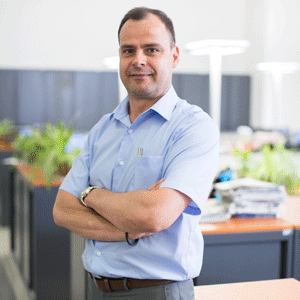THANK YOU FOR SUBSCRIBING

IIoT as a Catalytic Force in the Construction Sector
Matthew Marson, Global Market Sector Leader- Technology, Arcadis Uk (Ams: Arcad)


Matthew Marson, Global Market Sector Leader- Technology, Arcadis Uk (Ams: Arcad)
The Industrial Internet of Things (IIoT) has drastically impacted industries ranging from healthcare to agriculture. The construction industry is no exception. Recent statistics show that it’s only a matter of time before IIoT becomes a must-have technology in the construction sector. This emerging innovation will have a part to play in reducing construction costs, managing waste, improving employee safety, and above all, helping match properties against the requirements of prospective tenants. However, before the construction companies move into an IIoT-enabled and data-driven realm, there remain a few impediments they must address. Only then can they maximise their ROI for all IIoT endeavours.
The Biggest Challenge: A Lack of Digital SkillsIIoT is not just a brand-new technology for the construction sector but to the built environment in general. The construction sector has only come to see a slew of new IIoT-based hardware and software technologies entering the market in the last few years, with the quick appearance of intelligent buildings, warehouses, and manufacturing facilities. However, the legacy players in this sector lack the necessary domain knowledge to make the most out of their investments in IIoT. Thus, construction businesses need to learn the ropes of IIoT and develop strong digital problem-solving abilities, and at the same time, even upskill their workers around handling and implementing IIoT devices to master a wide range of business outcomes.
Focusing on the Value of SalesAnother major hurdle in wider IIoT adoption is the increasing gap between the dreams of the salespeople versus the reality of the product, which is often worlds apart. Many IIoT solution providers utilise industrial or digital buzzwords to present beautiful brochures or demos to their prospective clients in the construction sector. But, more often than not, these solutions turn out to be vapourware, i.e., they are either still in the development pipeline or possibly don’t offer the promised outcomes even after their successful implementation. It is necessary for construction businesses to be mindful about selecting a hardware and software vendor for their proven IIoT project successes.
Interestingly, this is where consulting companies can be helpful. They enable construction businesses to inculcate the required skills within their workforce and stay at the helm of the evolving trends. An experienced consultant can help businesses choose the right IIoT solutions based on the varying and unique needs of their construction projects. To allow implementation in a seamless way, consultants are required to have a structured approach to their projects. At Arcadis, we take a five-step approach whenever we work with a client on their IIoT projects. It starts with assessing different use cases required for your project. We’ll then support our clients in deciding the right hardware and software requirements. Once this groundwork is done, we then measure clients’ requirements against a myriad of industry-available IIoT solutions to decide on the best vendor. We even augment that with well-trained project managers, who have the necessary skills in IIoT to mitigate the industry’s knowledge gap. And finally, we back it up with a constant collaboration with the clients to help them derive intelligence from their IIoT data.
Emerging Innovation Will Have A Part To Play In Waste Management, Employee Safety Improvement, Construction Cost Reduction, And Helping Match Properties Against The Requirements Of Prospective Tenants
Three Golden Rules for Up and Coming Entrepreneurs If the young entrepreneurs of the construction sector want to flourish in today’s competitive landscape, they can not overlook the value of technology in buildings. They must invest love and care in their datasets to drive fundamental changes in traditional construction projects. Only if entrepreneurs have the means to utilise data to its full potential, can they then turn any construction project into an intelligent building or campus—delivering exceptional and sustainable outcomes safely and consistently. To ensure such improved outcomes and security at the same time, entrepreneurs need to abide by three golden rules in their information workflows.
The first one is about asset naming convention using industry-standard, consistent, and understandable keywords. That way, you and your construction workers can easily track any performance issue within the construction sites or facilities. It would even help you identify any spoof attack on your IIoT network.
The next is the use of appropriate network definition rules. With manufacturer usage descriptions, construction companies can impose stricter network security in terms of who and which device can connect to the IIoT network and what they/it can do on it.
And then, the final one is about having software segregated networks. This will not only allow you to group certain networks together and prevent them from overlapping but will also help in limiting any cybersecurity attack on your infrastructure.
With the above rules, entrepreneurs will be able to ensure that they conduct business to the highest professional standards around the globe and make the most from their construction projects in this digital era.
Weekly Brief
I agree We use cookies on this website to enhance your user experience. By clicking any link on this page you are giving your consent for us to set cookies. More info
Read Also













